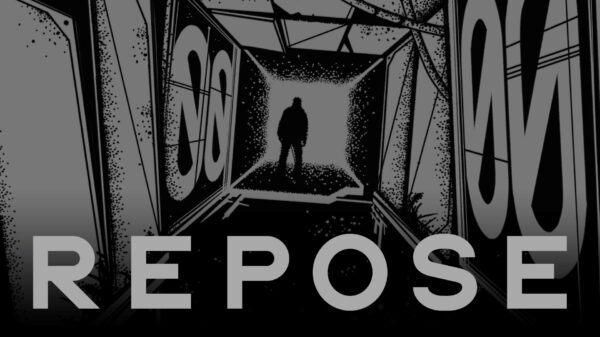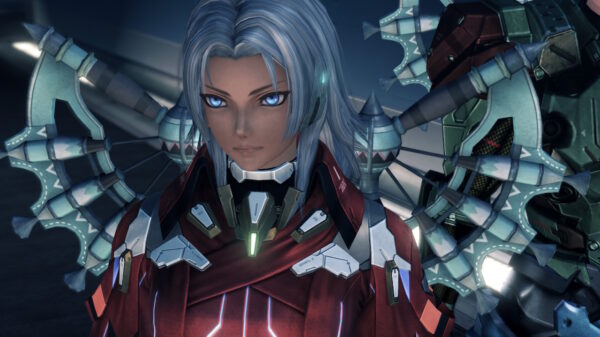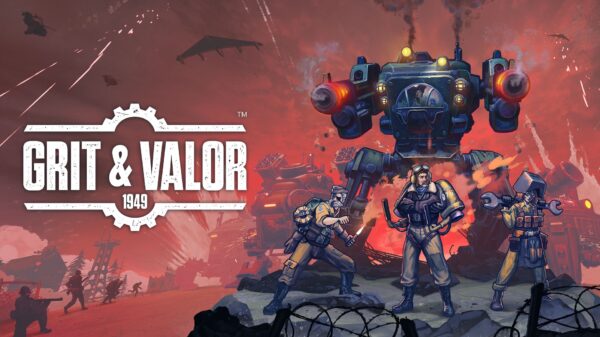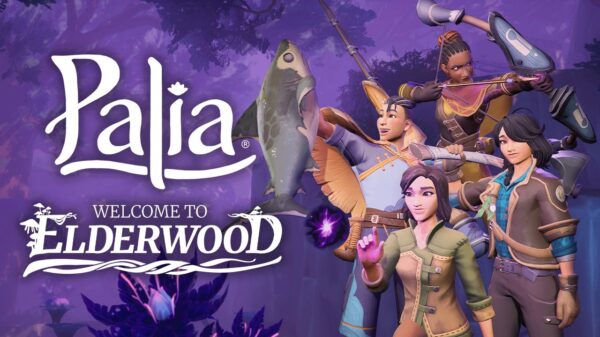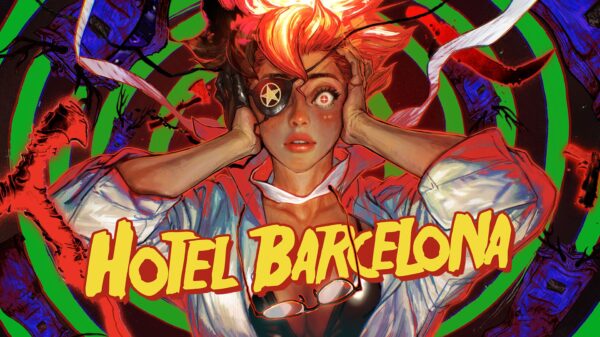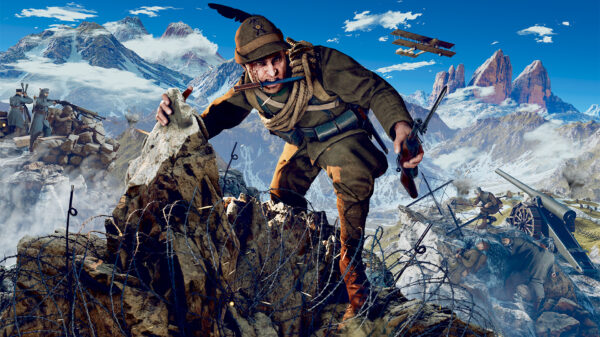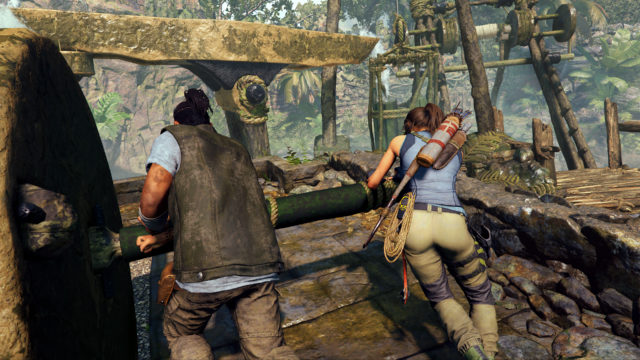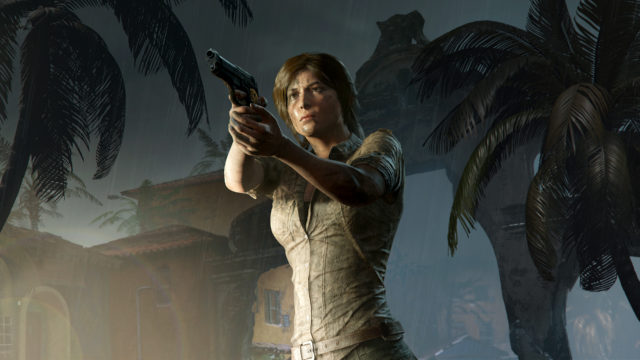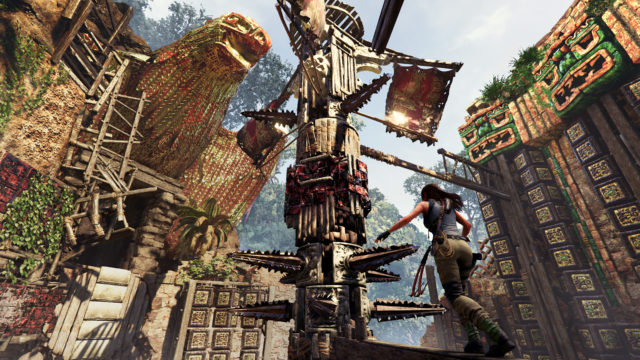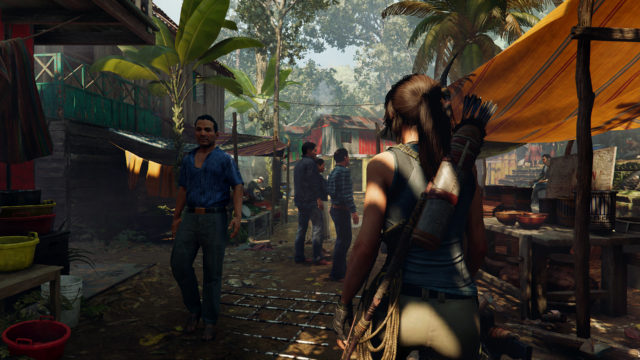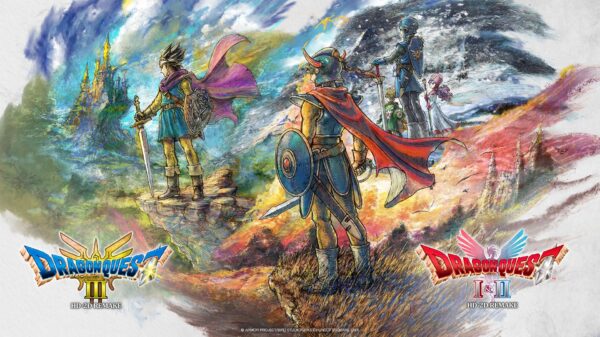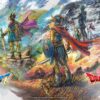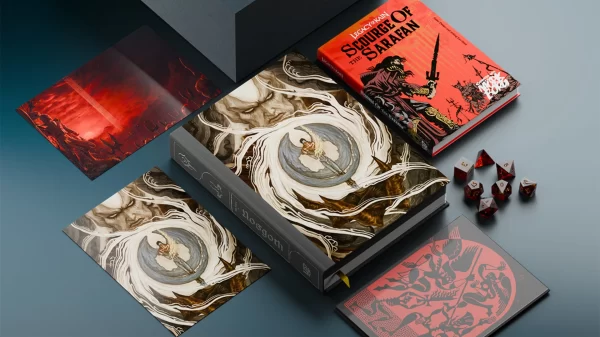Lara Croft’s focus on the imposing jaguar is unwavering. Every swipe of the animal’s razor-sharp claws is a reminder of the danger the adventurer finds herself deeply ensnared in. The battle is vicious and as it winds down after a few well-placed shots from her bow, the damage is noticeable. The dead animal leaves behind a large gash running down Lara’s shoulder. Blood and dirt mix as a reminder of the jungle’s harsh environment. Jonah, Lara’s companion, who has already suffered a wound, convinces her to set up camp for the night.
Under the stars and next to a warm fire, the two take a chance to connect in a personal, human way. The jungle’s darkness surrounds the companions, but in their downtime it can’t touch them. It’s an important scene that helps set Shadow of the Tomb Raider apart from the previous entries in the series. The scene is what helps Eidos Montreal, the studio leading development on the latest entry in the modern Tomb Raider trilogy, tell a darker, but more human tale for Lara Croft.
At a recent preview event in Manhattan Beach, CA., Eidos showed off the first five hours of Shadow of the Tomb Raider. For the purpose of this preview, I skipped the intro hour of the demo, as MonsterVine played through it twice. For a look at the intro, read our preview coverage.
Developing a Friend:
Let’s step back to the scene between Lara and Jonah. The story in Shadow of the Tomb Raider is not simply Lara saving the world from an apocalypse and becoming the “Tomb Raider.” In a lot of ways, the story is about Lara learning that her actions breed consequences for the people around her. In order for her to come to that sobering realization, the supporting cast of characters, like Jonah, need to be built up.
“One of the things that was really important for us is to really explore the inner conflict or what she’s experiencing … we needed to have something that was familiar to her that she can trust,” said Senior Game Director, Daniel Chayer-Bisson.
At times, their relationship will come to a head, as Jonah tries to balance between supporting Lara and standing up to her when he feels her actions are reckless. “Jonah I feel a lot of ways, really fights to remain an equal partner on this journey,” said Lead Writer, Jill Murray.
I witnessed some of that tension in the demo. As Lara runs through the checklist of things they need to accomplish in their journey to the Peruvian jungles, Jonah holds his tongue and looks like he’s about to explode.
“He has this really solid presence, even though he’s a very gentle and grounded character,” Murray said. “I think he really makes himself impossible to ignore.”
Flipping Priorities:
The focus on characters and dialogue is part of a change in development priorities for the third installment. In the past two games, emphasis went towards the big explosive set pieces, which can be described as “Priority One,” or “P1” for short. “P2” in the past would be how to drive the story in terms of action. And “P3” was reserved for moments like the one between Lara and Jonah.
Those “P1s” receive a lot more time and resources, and are typically untouched if content needs to be cut from the game. “P3s” are usually the first to go not because it’s disposable, but because it’s “nice if you can have it.” But for Shadow of the Tomb Raider, the team has flipped it. The dialogue and quiet, slower moments are now “P1” in Shadow of the Tomb Raider, which means scenes like the Lara and Jonah campfire conversation are protected.
“By doing that, it creates something that was way more personal, and emotional than we ever did before,” Bisson says.
That doesn’t mean the set pieces will be diminished in favor of the story. It just means that when those explosive moments happen, the player will better understand the motivations driving the characters. There’s more on the line for the player when they see the people they’ve invested in go through harrowing moments.
Refining Combat:
Eidos has worked to give players mechanics that can help refine the combat. For starters, Lara can equip different types of clothing and armor throughout her adventure. Each piece (separate upper and lower pieces) she finds or earns will grant her different buffs, like increase stealth, or better protection against enemies.
For example I was able to use jaguar skin for better enemy awareness and quiet movement. But if I swapped out the top layer of jaguar of skin, I would lose the enemy awareness in exchange for another buff.
On top of the benefits of using different clothing, Lara can use a variety of herbs to add temporary boosts to her stats. One of those boosts is an increase in perception, which allowed me to better search for items, or in combat situations, keep me fully aware of enemy movements.
These new additions to the game add a really interesting layer on top of the game’s skill tree. Aside from increasing damage and resistance, there are abilities that provide more tactical options for the player. I left the demo with the impression that I could design Lara to be stealth focused, or more action focused. The benefits from the herbs and armor further allowed me to craft a play style that’s different than the “Jill of All Trades” role it was easy to fall into previously in the series.
The combat in this sense, feels inspired by Eidos’ other franchise, Deus Ex. That series has always given players a wide berth of tactical options for tackling any given scenario. But it’s also possible for the player to completely tailor their character for a specific style of play.
Traversal and Exploration:
The traversal in the modern Tomb Raider series has maybe been one of its weaker elements. Scaling walls and making death-defying leaps between rock formations looks cool on screen, but made traversal feel less like a mechanic. Rise of the Tomb Raider, the second entry in the trilogy, was designed with more small-scale open areas that fixed some of the issues, but exploration still felt like being led around by the hand.
For Shadow of the Tomb Raider, a lot of noticeable work has gone into making traversal feel more interactive. One of the ways Eidos is trying to bring back a sense of challenge is through its customizable difficulty settings. Players will be able to adjust the difficulty of exploration like getting rid of any indicators in the world that show Lara the path. The harder difficulty for exploration also meant you have less reaction time for button prompts when grabbing onto ledges.
A great example of the game’s renewed efforts into exploration came when I discovered a hidden challenge tomb. I had the exploration difficulty set to normal, which means the indicators for where to go are less noticeable but not totally omitted. A pathway, covered in yellow paint was blocked from me due to not having the right gear.
As I veered off form that path I found a cliff that also had some paint on it. I assumed it was the exit for the previous pathway, but I jumped down the cliff anyways for fun. My assumptions were wrong, as it actually led me to a completely separate challenge tomb.
Part of the exploration in Shadow of the Tomb Raider will take place in the hub areas of the game. The demo took me to the small dusty village of Kuwaq Yaku. This little area had several branching paths for me to explore, which led to side quests and several collectables.
But I bring up Kuwaq Yaku because it ties back to Lara’s arc in Shadow of the Tomb Raider. Once I started to explore the village, I found a couple embracing each other at small table overlooking a beautiful lake. That quiet moment gave the world context in a way the series has rarely explored. It reminded me of exploring Prague in Deus Ex: Mankind Divided, Eidos’ most recent game. The city of Prague was not large, but it was dense with world building, which made it feel like a lived-in place.
The couple sitting at the table made Kuwaq Yaku felt like it was a real place.
“That goes with the vision we had for the hub itself. It’s about life, we’re celebrating life,” Bisson says.
But, for Lara, it’s a place that could easily be affected by her actions. “From the get-go, we had way more emotional relationship with the world than we did previously in Tomb Raider. Because before that, it was ‘woman versus wild’,” Bisson says. “In [Shadow of the Tomb Raider] it is [Lara] understanding what life means because her action will have consequence.”
Obviously there’s more to the game past the four hours I got my hands on. Much of what I talked about in this preview may fall apart as the game goes on. Or it can turn out to be super rad. Either way, Shadow of the Tomb Raider shows a real effort to stand out from its two predecessors.
Shadow of the Tomb Raider launched September 14, 2018 for PlayStation 4, Xbox One and PC.





